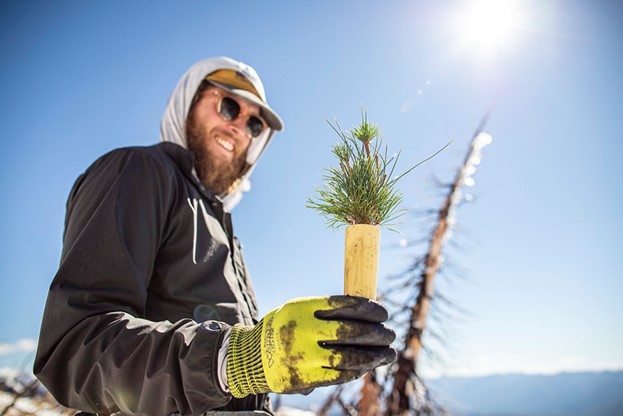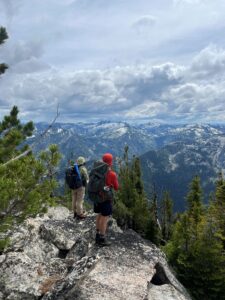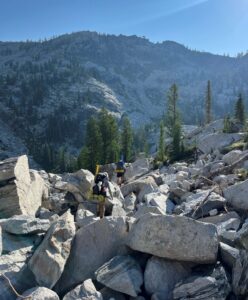
Student Spotlight: Joshua Beisel
As the field season approaches, we’d like to highlight a graduate student with field research underway in whitebark pine forests. Meet Joshua Beisel, a PhD student at the University of Montana, who is studying interactions between whitebark pine and wildfire dynamics with Dr. Andrew Larson. Josh’s interest in whitebark pine began when he was working as a technician at Glacier National Park, where he helped with whitebark pine cone and seed collection, planting, and monitoring. While planting seedlings in a burn scar on Mt. Brown, Josh was inspired to pursue research related to post-fire regeneration dynamics in whitebark pine forests. Learn more about Josh’s work in this Q&A, and stay tuned for his preliminary findings in the upcoming spring issue of Nutcracker Notes!
Why is it important to study the relationship between whitebark pine and fire?
The relationship between whitebark pine and fire is complex and somewhat paradoxical, which I think makes it inherently interesting. “Altered fire regimes” is also one of the threats identified in the recent US Fish and Wildlife decision to list whitebark pine as Threatened under the Endangered Species Act. Consequently, there is a strong conservation/restoration motivation to learn more about this relationship. Whitebark pine is really good at regenerating and establishing after fire, but mature trees are not particularly fire tolerant. Given that whitebark pine populations are facing threats from many other directions (e.g., blister rust, mountain pine beetle outbreaks, climate change, competition from shade-tolerant species), we are actively learning about how fire interacts with these other drivers. Continued research on the fire ecology of the species will be necessary to inform management practices in an uncertain future.

Looking south into the Bitterroot Mountains, near Gash Point, MT. Image credit: Meg Leonardi.
Could you provide a brief overview of your project?
Broadly, my project is focused on investigating how fire affects interactions between trees in treeline forests. Whitebark pine distribution straddles a unique elevational zone, known as the alpine treeline ecotone, where forest dynamics can differ quite a bit from one end to the other. If you’ve ever hiked from a valley bottom up into the alpine, you’ve seen this transition (and hopefully) seen how whitebark can grow in relatively dense subalpine/montane forests, all the way up to some of the harshest environments where trees can grow. I’m interested in understanding how the effects of fire may differ across this gradient. Environmental stress increases quite rapidly across this zone, and previous research suggests that the dominant interactions between trees switch from one end to the other. Trees tend to compete for resources at the lower end of the ecotone, but facilitation (positive interactions) can occur at the upper end. I am hoping to understand how fire may disrupt and/or alter these interactions.
What data are you collecting to address your research questions?
Our sites were distributed throughout the Bitterroot Mountains, where we sampled mature trees in burned and unburned forest in the upper and lower alpine treeline ecotone. This included subalpine fir, Engelmann spruce, and subalpine larch, in addition to whitebark pine. At each site we recorded forest structure in the area around each sample tree and extracted tree cores to measure growth before and after the fire events. This sampling design also allowed us to quantify seedling and sapling communities in our plots. I hope to analyze this data in order to explore the factors associated with successful whitebark pine establishment after fire.
The project also has a large dendrochronology component. One of our main research questions is related to how fire affects surviving tree growth across different elevations and species. After you collect tree cores in the field, they have to be transported back to the lab where they are sanded, scanned, measured, and cross-dated (we ended up with ~ 1,100!). This requires many hours, but the payoff is a really unique dataset that allows you to see how old a tree is and how much it grew in every year of its life. You can also see how yearly climate affected its growth, which may reveal some important information about how these trees will respond to climate change. I am still finalizing this dataset; however, my preliminary measurements have revealed that some whitebark in our sample are over 500 years old!

Hiking through talus to on the way to a field site in Bitterroot Mountains. Image credit: Olivia Vergin.
What is a common misunderstanding regarding whitebark pine and wildfires?
On the whole, there are a lot of ideas that miss the nuances regarding whitebark pine and fire. One of these is that whitebark pine is a fire resistant or tolerant species. Whitebark pine ecosystems have evolved with fire, and fire is an important part of whitebark regeneration. However, the current state of whitebark populations is forcing us to shift our thinking some and emphasize the mortality side of fire effects, in addition to post-fire WBP regeneration. Whitebark is more fire-tolerant than many of the trees it grows with, such as subalpine fir or Engelmann spruce, but recent work suggests that mature whitebark pine are quite susceptible to being killed by fire. In areas where mature, cone-bearing whitebark are sparse, fire-caused mortality of even a few trees could further reduce an already dwindling seed source. However, if there are healthy trees close enough to a fire and Clark’s Nutcrackers around to cache the seeds, that event is likely a net benefit to the population. Prescribed fire can be a very effective conservation/restorations strategy, but it needs to be carefully implemented to avoid killing mature trees, and perhaps combined with planting rust resistant seedlings.
There are also some things we don’t know, which I am hoping to address in my work. Do whitebark pine that survive fire respond differently across elevations? How about the other species it grows with? Rather than something that is consistent and well-defined, the response of whitebark pine to fire is highly context dependent.
How will your research inform conservation efforts and management strategies?
I hope that the findings from my research can help us understand the synergistic effects of fire and climate change on high elevation forests, informing predictions of what these forests will look like in the future. Ideally, this knowledge will help land managers better understand when and how fire in treeline forest supports a given management objective. I also see the analysis of our seedling and sampling data as another piece of information that can help focus planting efforts in areas where they are most likely to succeed. The more we understand about the system, the higher likelihood there is of management actions having the intended outcome.
What is the future of whitebark pine forests amidst changing wildfire regimes?
Fire will and should have a role in whitebark pine ecosystems into the future, but I think how we manage fire for whitebark pine will need to become increasingly strategic. Absent of active management, I worry that increases in area burned and fire frequency in high elevation forests would have a negative impact on whitebark pine populations. On the other hand, we have become acutely aware of the pitfalls associated with trying to suppress all fires.
Having good data about where healthy cone-bearing trees are located, as well as identifying where and when planting rust-resistant seedlings will be effective, is essential to maintaining whitebark on the landscape. This will mean balancing whitebark conservation/restoration focused goals with other wildfire management objectives and firefighter safety. As with other complex problems, there probably is not a one size fits all solution. I think it will look different across the range of whitebark pine and the various land management agencies that oversee it.

